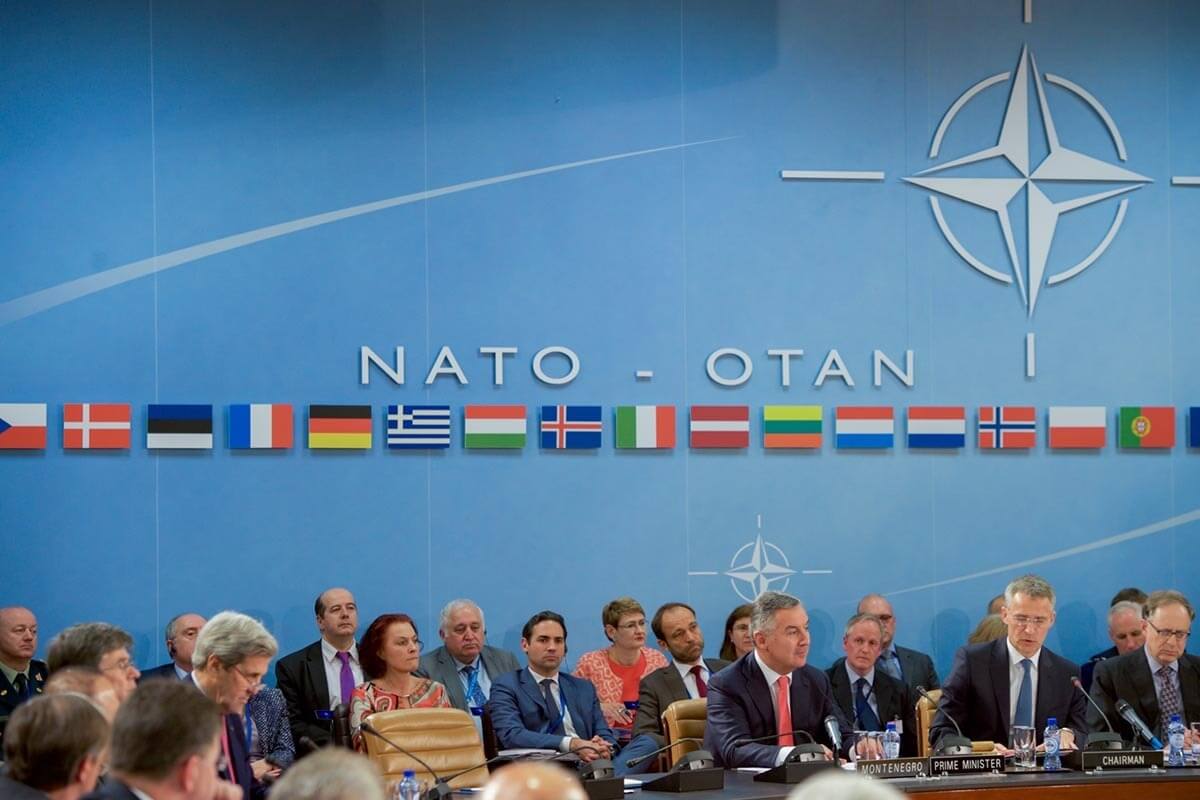In the fall of 2021, I wrote a piece for EITW that examined U.S.-European security cooperation in the wake of the abrupt U.S. exit from Afghanistan. In that article, I argued that despite numerous disputes within NATO concerning the Middle East, the transatlantic alliance has remained robust on its foundational goal: the security of Europe. At that time, few could have guessed the challenge NATO would soon face in the form of the Russian invasion of Ukraine. Representing the greatest security threat to Europe since the end of the Cold War, the escalation of the war in Ukraine in February 2022 generated a pivotal moment for the future of the transatlantic alliance. A year since the full-scale invasion began, what can be said of the strength of U.S.-European relations?
While the fighting in Ukraine is likely far from over, one clear lesson is that the death of NATO was very much exaggerated. Since Russia first launched attacks throughout Ukraine, the efforts of Washington and Brussels to arm and assist Ukraine have been significant. In 2022, the U.S. and European states sent a combined aid of over 100 billion euros, a total which included both weaponry and humanitarian supplies. Additionally, a few weeks into the conflict, they both coordinated to impose a sweeping sanctions regime against Russia. More impressive still is that much of these efforts have proceeded with few public disputes among or defections from the Western Bloc.

Beyond supporting Ukraine and sanctioning Russia, the invasion has prompted NATO members to take further actions to strengthen the alliance. Sweden and Finland, both of whom had pursued a nonaligned position between Europe and Russia, quickly pivoted to seek NATO membership. Similarly, Germany and Spain, who have long neglected defense spending, committed to bolstering their militaries over the next few years. By all accounts, U.S.-European relations have come a long way from President Macron’s declaration in 2019 that NATO was becoming “brain dead.”
While the renewed zeal for transatlantic security cooperation can be partially attributed to the renewed threat of Russia to Europe, simple changes in threat perception fail to fully explain the observed shifts in how the U.S. and Europe have cooperated. A coordinated response from the Western Bloc was far from certain at the outset of the conflict, an uncertainty on which Putin wagered the success of his “special military operation.” To this end, there are two critical elements which placed NATO cooperation on firmer ground: the Biden Administration’s light-touch approach to U.S. leadership of the alliance and the relative acquiescence of Europe’s belligerent dissenters.
A key factor in the success of recent NATO cooperation has been a change in how the U.S. approaches its leadership of the western bloc. Instead of publicly forcing Europe to adopt the positions of Washington, the Biden Administration has let its European partners take the lead in determining how far they are willing to go to support Ukraine. Two examples of this strategy can be seen in the initial sanction packages against Russia and the recent decision of Germany to send its Leopard 2 tanks to Ukraine. In both instances, not only have many of the inter-alliance debates been kept from the public (a stark juxtaposition to the Trump years), but those that have spilled over into public discourse reveal the main point of contention is between European states themselves. Notably, states such as the UK and Poland have outflanked the U.S. in calling for more advanced and destructive weaponry to be delivered to Ukraine. To this end, official announcements on U.S. commitments to Ukraine have generally come after European states reached at least a partial consensus among themselves.

This is not to say, however, that the U.S. has forsworn its leadership of NATO. By the numbers, the U.S. has taken on the heaviest share of the financial burden to assist Ukraine, and Washington still holds an implied veto on any significant decision. With that said, the more collaborative style adopted by the Biden Administration reflects a recognition of the issues that have hampered U.S.-EU cooperation for decades. The unilateral approach to the War on Terror involved either bypassing Brussels entirely or publicly pressuring European leaders to fall in line. Such actions created the impression that the U.S. saw its European allies as junior partners, breeding resentment and skepticism towards American leadership. U.S. leadership itself became an open question for European leaders, culminating in the “strategic autonomy” position proposed during the Trump Administration. Knowing that any forced unity in response to the Russian invasion would create a fault line dissenters could exploit, Washington has wisely allowed much of the negotiation regarding NATO’s involvement to occur among its European partners.
The second critical factor to the thus far successful cooperation has been the relative passivity of the Western alliance’s dissenting leaders. Surging populism throughout Europe has brought the ascendance of leaders who have openly questioned the legitimacy and utility of NATO following the Cold War. Leaders like Prime Minister Viktor Orbán of Hungary and President Recep Tayyip Erdoğan of Turkey made overtures to Russia in the years preceding the war. However, their actions since the invasion have indicated, at the very least, an unwillingness to obstruct the efforts of their allies. More so, other populist leaders such as President Andrzej Duda of Poland and Prime Minister Giorgia Meloni of Italy have been enthusiastic in their support of NATO’s role in aiding Ukraine. While these populists have frequently used NATO and other international institutions as a punching bag to rally their domestic base, there has been little public dissent, let alone action, in the year following the invasion.
...perhaps U.S. leadership has recognized that the transatlantic alliance remains robust only when it is focused on its foundational concern: Europe's physical security.
Just as renewed U.S.-European security cooperation was far from inevitable, one should not treat it as inherently sustainable. Washington’s willingness to foot a large share of the bill has focused much of the inter-alliance negotiations on questions of escalation instead of burden sharing, which are easier to manage. Additionally, the current passivity of the dissenters may not endure for much longer. Turkey and Hungary’s obstruction of Finland and Sweden’s ascension to NATO is indicative of the intra-alliance disagreements which may spoil renewed cooperation. More critically, a protracted war, combined with the economic costs of ongoing sanctions, will likely wear down even Ukraine’s most ardent supporters. If Europe’s economic situation turns dire, leaders will likely face domestic challenges over their continued contributions.
Beyond Ukraine, large questions remain concerning the prospect of NATO security cooperation in the changing landscape of international politics. Most importantly, U.S. attempts to form a Western coalition to counter the rise of China have been met with little tangible support and sizable skepticism. This muted response from many European states is not surprising given their deep economic ties with China’s markets and the limited saliency of China’s threat relative to the perspective of the United States, the latter of whom sees China as its primary challenger.
To this end, perhaps U.S. leadership has recognized that the transatlantic alliance remains robust only when it is focused on its foundational concern: Europe’s physical security. This is not to say that it is impossible for the U.S. and Europe to coordinate a response to China, but it might be best, for the sake of sustaining their renewed cooperation, to not test their luck.
Further recommended reading
- Jonathan Masters, “Ukraine: Conflict at the Crossroads of Europe and Russia,” Council on Foreign Relations (February 14, 2023).
- Ross Douthat, “Will the Ukraine War End the Age of Populism?" The New York Times (March 16, 2023).
- Stephen Walt, “Friends in Need: What the War in Ukraine Has Revealed About Alliances,” Foreign Affairs (February 13, 2023).
About the author

Harrison Greenleaf is a third-year Ph.D. student at the University of Notre Dame, specializing in international relations. His research interests lie within international security, alliance politics, and U.S. foreign policy, particularly in Europe and the Middle East. At Notre Dame, he plans to focus on U.S. bilateral and multilateral security alliances, with a specific emphasis on comparing how the U.S. leverages NATO and Saudi Arabia alliances to pursue its broader security agenda. Harrison received his B.A. at Michigan State University, with a double major in international relations and political theory.
Originally published by at eitw.nd.edu on April 13, 2023.